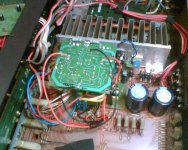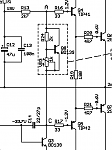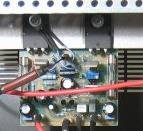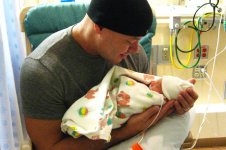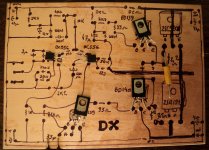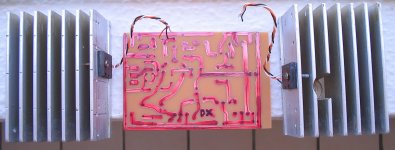the beach has sharks.... will try a club with a big swimming pool.
Thank you.... it was very stupid but i really have not imagined that..swimming is a very powefull exercise as uses more muscles..also it is pleasant...i love to swim underwater and weather here is good for that... we are having 25 celsius these last weeks.
regards,
Carlos
Nicely, ... but with me in Macedonia is 37 degrees Celsius!


Cheers !
Ok, I made it
First, it was dedicated to replace hard to find original stk,
but i like it, works like a charm, deep solid bass, bright precise mild, and nice highs,
small heatsink force me to reduce idle current, but works fine
very good amplifier, thanks Carlos
Karlo
First, it was dedicated to replace hard to find original stk,
but i like it, works like a charm, deep solid bass, bright precise mild, and nice highs,
small heatsink force me to reduce idle current, but works fine
very good amplifier, thanks Carlos
Karlo
Attachments
Hi all!
A vey, very broad topic!? The amplifier is very interesting!
So at the end makes the final set schematic with thermal loop amplifier for bias (circuit wih transistor for bias - see figure) the output transistors 2SC5200/2SA1943.
And of course set the PCB for this amplifier!
I pray Alex mm (POP) to develop, if it is able for the final PCB design amplifiers.
thanks and cheers !
P.S.
With this circuit the bias !

A vey, very broad topic!? The amplifier is very interesting!
So at the end makes the final set schematic with thermal loop amplifier for bias (circuit wih transistor for bias - see figure) the output transistors 2SC5200/2SA1943.
And of course set the PCB for this amplifier!
I pray Alex mm (POP) to develop, if it is able for the final PCB design amplifiers.
thanks and cheers !
P.S.
With this circuit the bias !
Attachments
Last edited:
This amplifiers is a product from it's own period of time.... had influences
from Aksa..... actually was based in Aksa 55, a very sweet design made by Hugh Dean, the Aspen Amplifiers CEO.
Hugh use to lay down the thermal sensor that is assembled atop of the NPN driver, using same screw that fixes the NPN driver...some wires runs to the board..and there's the BD139 capturing heat atop from the 2SC5200.
So, his style.... his fashion way to do this..also a good technical decision, because this way no insulator is needed...the 2SC5200 face is made of insulating material and we got rid from washers, insulators and all that stuff.
So, this kind of instalations is a kind of pedigree certificate.... people loved that.... i don't....but i know people love that.... hundreds have built this way.
I use to criticise this when talking to Hugh.... but this is Stylish...became a brand sign .
This kind of topologie, the main structure, was used by all audio brands from 1970 to 1980.... really all brands have used this schematic with some small different values here or there.... Pioneer, Kenwood, Philips, Marantz, Mcintosh and all famous others (JVC too) have used...inside STK chips we had this schematic made in an integrated form...also the LM3866 (that famous gainclone chip... ID number can be other than that) uses this topologie with some modifications, it uses quasi complementary output and they have added a lot of protections, short circuit, over current, over voltage, over temperature..... and that resulted worse performance when compared to the discrete counterpart...LM power if keep low (20 watts) result great..but if you try to increase then audio becames not that good, protections enters and kills sonics.
So, a very good schematic... and performs very well.... something that cannot beat more modern circuits but will never be ashamed, because if loose in a comparison, the audible difference will not be that big.
The small transistor laying down over the big one has family connections inside our mind...looks a baby sleeping over daddy or mum breast.... this is Hugh touch of gênius...made it look family... this code is detected by our subconscience.... great idea!
regards,
Carlos
from Aksa..... actually was based in Aksa 55, a very sweet design made by Hugh Dean, the Aspen Amplifiers CEO.
Hugh use to lay down the thermal sensor that is assembled atop of the NPN driver, using same screw that fixes the NPN driver...some wires runs to the board..and there's the BD139 capturing heat atop from the 2SC5200.
So, his style.... his fashion way to do this..also a good technical decision, because this way no insulator is needed...the 2SC5200 face is made of insulating material and we got rid from washers, insulators and all that stuff.
So, this kind of instalations is a kind of pedigree certificate.... people loved that.... i don't....but i know people love that.... hundreds have built this way.
I use to criticise this when talking to Hugh.... but this is Stylish...became a brand sign .
This kind of topologie, the main structure, was used by all audio brands from 1970 to 1980.... really all brands have used this schematic with some small different values here or there.... Pioneer, Kenwood, Philips, Marantz, Mcintosh and all famous others (JVC too) have used...inside STK chips we had this schematic made in an integrated form...also the LM3866 (that famous gainclone chip... ID number can be other than that) uses this topologie with some modifications, it uses quasi complementary output and they have added a lot of protections, short circuit, over current, over voltage, over temperature..... and that resulted worse performance when compared to the discrete counterpart...LM power if keep low (20 watts) result great..but if you try to increase then audio becames not that good, protections enters and kills sonics.
So, a very good schematic... and performs very well.... something that cannot beat more modern circuits but will never be ashamed, because if loose in a comparison, the audible difference will not be that big.
The small transistor laying down over the big one has family connections inside our mind...looks a baby sleeping over daddy or mum breast.... this is Hugh touch of gênius...made it look family... this code is detected by our subconscience.... great idea!
regards,
Carlos
Attachments
Last edited:
And of course set the PCB for this amplifier!
I pray Alex mm (POP) to develop, if it is able for the final PCB design amplifiers.
Hi radio,
I have a couple of 2010 PCBs left over from my personal stock so if you are interested PM me. They are not OFFICIAL PCBs as they are changed a little to my preferences, but close enough to the original design. Differences that I can remember, no zobel on PCB, added emitter resistors under PCB, bypass caps under board.
regards
Attachments
Hi Friends!
I want to ask something about this amplifier ?
What are the experiences with this amplifier ?
What makes a sound ?
Is someone has made some measurements and e.t.s.
I ask because I can not decide between this amp and amplifier with IC-TDA7250 and output transistors 2SC5200/2SA1943?
thanks
I want to ask something about this amplifier ?
What are the experiences with this amplifier ?
What makes a sound ?
Is someone has made some measurements and e.t.s.
I ask because I can not decide between this amp and amplifier with IC-TDA7250 and output transistors 2SC5200/2SA1943?
thanks
Last edited:
Just finished the DX amp kit. A big thumbs up to Carlos. 
Initially, I did not think it sounded as good as the NAP-140 kit on my small work bench speakers; but paired with my Magnapan MMGs, it easily sounded better, cleaner more dynamic sound & better sound stage.
Compare to the Helder TK2050 amp I have been using with the MMG, the TK2050 is a tad more dynamic, but it is not as smooth as the DX amp. Overall, I prefer the DX amp. Look like the DX amp is doing MMG duty, after I install a few upgrade parts.
Now I am curious as to how much better the DX Blame is compare to the DX amp.

Initially, I did not think it sounded as good as the NAP-140 kit on my small work bench speakers; but paired with my Magnapan MMGs, it easily sounded better, cleaner more dynamic sound & better sound stage.
Compare to the Helder TK2050 amp I have been using with the MMG, the TK2050 is a tad more dynamic, but it is not as smooth as the DX amp. Overall, I prefer the DX amp. Look like the DX amp is doing MMG duty, after I install a few upgrade parts.
Now I am curious as to how much better the DX Blame is compare to the DX amp.
So, the charge is yours...for life long.
regards,
Carlos
Thanks Carlos.
scope probes
Hi Nordic,
Where did you get these mentioned scope probes? I am looking for a pair and they are expensive.
Thanks
Graham, on the probes, is it better to get hi-Z probes, I had a bit of good fortune and will be phoneing a local company who specialises in serviceing and reselling old scopes...tommorrow.
Hopeing to get something analog.
Hi Nordic,
Where did you get these mentioned scope probes? I am looking for a pair and they are expensive.
Thanks
I am building more three Dx amplifiers... one for my student
Mr. Lucas .... and two others to my own use.
You can have videos showing the simple method to produce boards here:
Part 1 - Dx amplifier - build pcboard at home - YouTube
Part 2 - Dx amplifier - How to make pcboards at home - YouTube
regards,
Carlos
Mr. Lucas .... and two others to my own use.
You can have videos showing the simple method to produce boards here:
Part 1 - Dx amplifier - build pcboard at home - YouTube
Part 2 - Dx amplifier - How to make pcboards at home - YouTube
regards,
Carlos
Attachments
Just finished the DX amp kit. A big thumbs up to Carlos.
Initially, I did not think it sounded as good as the NAP-140 kit on my small work bench speakers; but paired with my Magnapan MMGs, it easily sounded better, cleaner more dynamic sound & better sound stage.
Compare to the Helder TK2050 amp I have been using with the MMG, the TK2050 is a tad more dynamic, but it is not as smooth as the DX amp. Overall, I prefer the DX amp. Look like the DX amp is doing MMG duty, after I install a few upgrade parts.
Now I am curious as to how much better the DX Blame is compare to the DX amp.
I have also bought a DX amp PCB and wonder if I should bother populating it if the Blame is much better....is it???
If you love bass and do not bother about treble
then the Dx Amplifier is the unit for you.
This does not mean the Dx amplifier does not reproduce treble .... it does and very well ...but the Blame is much better.
The bass in the Blame is very good...but the Bass in the Dx amplifier is awesome.
regards,
Carlos
then the Dx Amplifier is the unit for you.
This does not mean the Dx amplifier does not reproduce treble .... it does and very well ...but the Blame is much better.
The bass in the Blame is very good...but the Bass in the Dx amplifier is awesome.
regards,
Carlos
Thanks for the feedback DX. Can these differences be seen on simulation??? If not, maybe by "playing" with different component types especially cap types and also material of hookup wire could fix either of the amplifiers short comings? I was also very surprised to see (hear) the improvement tantalum resistors have over metal film and the improvements it made to my last DIY amplifier.
Last edited:
Simulator does not play music...you cannot "see" using simulator
You can "believe" low THD and IMD may produce results...but it is a matter of faith only...reality is much different..numbers means nothing or half of anything..there are low THD amplifiers sounding terrible (adjustments, tweaking, tuning, unbiased, saturated, bad designed, bad improved, bad tested) and high THD amplifiers sounding lovely (some Mcintosh are good examples).
I use to show my small numbers..because there are a lot of guys that believe this means something..then they will build because of numbers...they will feel good because my amplifiers sounds fine (Doctor Self inspired designs, almost copies or clones) and they will BELIEVE was because the THD...when was not this way...but the result obtained is amplifier built..this is progress...people is moving because their beliefs..so...their faith helps!
If you want to know the results you should build them in a fast and simple way as prototype...then evaluate by yourself..using your speakers, your ears, your home acoustics and your feelings (perception)..... finally decide the one you want and build it in a decent way...but knowing what is the best for you.
Each amplifier has a "sonic signature".... this may be the "conversation" in between the amplifier and the speaker...depends on the speaker and output damping and several other factors that i am not dare to explain as i do not know all them..... even a flat amplifier (electrically flat) will show better reproduction in bass, mids or trebles.... their "transference" of audio is better depending some frequencies.... measuring the unit is flat...listening it is not flat.
There's not a recipe to cook a cake while the issue (or pleasure) is an audio amplifier....reason why i waste (or keep myself happy and busy) building thousand of amplifiers along 51 years...and i am still learning... and knowing i am ignorant in many things ... and this is excellent as drives me on..... i know nothing but i feel good as there are several other guys that knows half of nothing .... so... i am above the average because i am old...a lot of years burning my fingertips made me understand something and create some skills...in special the skills needed not to fool myself.
Build and try, do not believe anyone.... everybody's biased .... some of them have nice results because home environment, home acoustics, speaker quality (matched) and nice recordings.....but if you move the nice recording to your home with other speakers, other home, other speaker, other pair of ears..them the result can be terrible.
Do it by yourself...build ... do not believe in numbers or opinions...do not believe what uncle charlie said...try to prove i am wrong..build my amplifiers!, try by yourself, do not ask questions alike these oens posted as you will have several different answers and you will be confused and will learn nothing...just that there are several different opinion and one may be right and several others will be wrong.....conclude by yourself.
Work hard and learn from your work...develop yourself and create the needed skills to obtain a real knowledge..... rules, practices, ideas, beliefs, faiths... all this is blowing in the wind..means nothing.
regards,
Carlos
You can "believe" low THD and IMD may produce results...but it is a matter of faith only...reality is much different..numbers means nothing or half of anything..there are low THD amplifiers sounding terrible (adjustments, tweaking, tuning, unbiased, saturated, bad designed, bad improved, bad tested) and high THD amplifiers sounding lovely (some Mcintosh are good examples).
I use to show my small numbers..because there are a lot of guys that believe this means something..then they will build because of numbers...they will feel good because my amplifiers sounds fine (Doctor Self inspired designs, almost copies or clones) and they will BELIEVE was because the THD...when was not this way...but the result obtained is amplifier built..this is progress...people is moving because their beliefs..so...their faith helps!
If you want to know the results you should build them in a fast and simple way as prototype...then evaluate by yourself..using your speakers, your ears, your home acoustics and your feelings (perception)..... finally decide the one you want and build it in a decent way...but knowing what is the best for you.
Each amplifier has a "sonic signature".... this may be the "conversation" in between the amplifier and the speaker...depends on the speaker and output damping and several other factors that i am not dare to explain as i do not know all them..... even a flat amplifier (electrically flat) will show better reproduction in bass, mids or trebles.... their "transference" of audio is better depending some frequencies.... measuring the unit is flat...listening it is not flat.
There's not a recipe to cook a cake while the issue (or pleasure) is an audio amplifier....reason why i waste (or keep myself happy and busy) building thousand of amplifiers along 51 years...and i am still learning... and knowing i am ignorant in many things ... and this is excellent as drives me on..... i know nothing but i feel good as there are several other guys that knows half of nothing .... so... i am above the average because i am old...a lot of years burning my fingertips made me understand something and create some skills...in special the skills needed not to fool myself.
Build and try, do not believe anyone.... everybody's biased .... some of them have nice results because home environment, home acoustics, speaker quality (matched) and nice recordings.....but if you move the nice recording to your home with other speakers, other home, other speaker, other pair of ears..them the result can be terrible.
Do it by yourself...build ... do not believe in numbers or opinions...do not believe what uncle charlie said...try to prove i am wrong..build my amplifiers!, try by yourself, do not ask questions alike these oens posted as you will have several different answers and you will be confused and will learn nothing...just that there are several different opinion and one may be right and several others will be wrong.....conclude by yourself.
Work hard and learn from your work...develop yourself and create the needed skills to obtain a real knowledge..... rules, practices, ideas, beliefs, faiths... all this is blowing in the wind..means nothing.
regards,
Carlos
Last edited:
- Status
- Not open for further replies.
- Home
- Amplifiers
- Solid State
- Destroyer x Amplifier...Dx amp...my amplifier

